The 6 Best Core Exercises To Do During Pregnancy—And Which To Avoid
Learn what the best and safest core exercises for pregnancy are, according to fitness experts, and how to add them to your workouts.
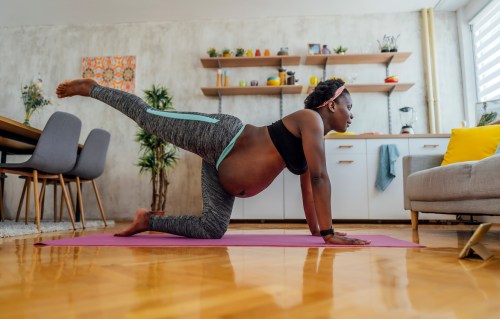
Having a little bean on the way brings a flurry of questions: Can I eat bacon? What type of cheese is on the safe list? Should I even be thinking about ab workouts?
Experts in This Article
former dancer, celebrity fitness trainer, and owner of Anna Kaiser Studios
a pre- and postnatal certified trainer based in Sarasota, Florida
While it may feel counterintuitive to do core exercises when you’re pregnant, it’s actually very important to alleviate back pain, prepare yourself for labor, and speed up your postpartum recovery time.
“Your entire midsection is working so hard to support your growing baby,” says Kim Perry, CPT, a pre- and postnatal certified trainer based in Sarasota, Florida. “I recommend pregnant [people] integrate core work into their fitness routine and focus on the deep core muscles that will help improve your posture and mitigate some of those pesky pregnancy symptoms.”
For instance, the transverse abdominis is a major core muscle that wraps around your stomach and back. It acts like a corset by supporting your core and reducing stress on other various muscles in your abdominal region. It also helps to prevent diastasis recti, in which the left and right sides of your abdominal muscles can split during pregnancy, Perry adds.
Core stability exercises were more effective than usual care in relieving pain and boosting the quality of life for pregnant people with pain in their lower back and pelvic area in a January 2023 study published in the Journal of Manipulative and Physiological Therapeutics.
However, once you’re expecting, you might need to change the type of core exercises you do. It’s important to avoid certain types of core exercises, which include traditional go-to’s like crunches.
“Core exercises are incredibly important during pregnancy, but your focus should shift on how you approach your core work,” says Anna Kaiser, CPT, a pre- and postnatal certified trainer and CEO of Anna Kaiser Studios in New York City. “And depending on the person, you should avoid adding weight or intensity once you get pregnant. Continue working out at the same level you were before getting pregnant.”
Here are the six best core exercises for pregnancy, demonstrated by Perry—plus, three moves to avoid.
Safe core exercises for pregnancy
1. Offset squat
“This move is an anti-tilt challenge for the core,” Perry says.
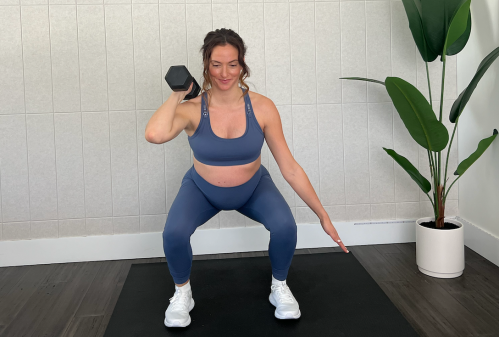
- 1.Stand tall with your feet hip-width apart, arms by your sides. Hold a dumbbell in your right hand (palm facing in toward your body).
- 2.Lift the dumbbell up so that the head of the dumbbell rests on your right shoulder, palm facing in.
- 3.Engage your core by drawing your belly button in, as if you’re giving the baby a hug.
- 4.Bend your knees and push your hips back to lower toward the floor. Pretend as though you were going to sit on a chair.
- 5.Lower down as far as comfortable, or until your thighs are parallel with the floor.
- 6.Pause for a moment at the bottom of your squat. Resist the tilt from the extra weight on your shoulder.
- 7.Press through your heels to return to standing.
- 8.Complete 12 to 15 reps on each side.
2. Belly breathing
Also known as diaphragmatic breathing, this is a foundational move for core engagement during and after pregnancy. It may seem “simple” for a core workout, but it actually plays a very important role.
“The movement of your pelvic floor mimics the movement of your diaphragm,” Kaiser says. “If you are breathing into your chest and using your secondary breathing muscles, your neck and chest muscles will get tighter and your pelvic floor will not condition itself as it would if you were focused on deep belly, diaphragmatic breathing.”
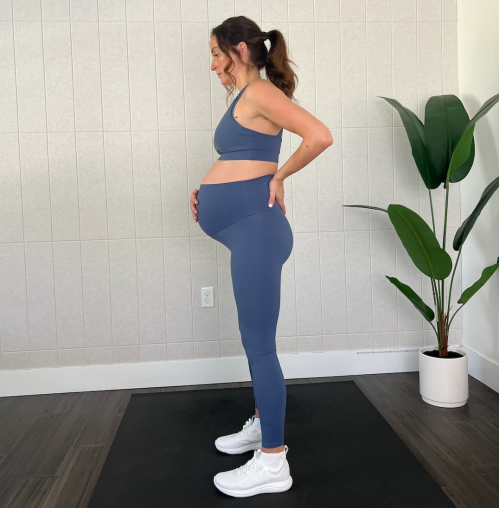
- 1.Stand tall with your feet hip-width apart.
- 2.Place your right hand on your belly and your left hand on your hip or lower back.
- 3.Take a deep breath in, filling your belly with air.
- 4.As you exhale, think about first lifting your pelvic floor, then wrap your abdominals like you are gently tightening a corset from hip to hip.
- 5.Complete 5 to 10 reps.
3. Bird dog
The bird dog “requires a lot of focus and stability,” Perry says. “If you notice yourself wobbling, you can bring your toes to the mat for more support.”

- 1.Start in a tabletop position on your hands and knees. Your hands should be directly in line with your shoulders and your knees should be directly in line with your hips.
- 2.Inhale, then exhale to engage your core as you lift your right arm straight out in front of you.
- 3.At the same time, reach your left leg straight behind you, fully extending your knee.
- 4.Pause for a moment, then return to starting position.
- 5.Repeat on opposite side, lifting your left arm up and your right leg back.
- 6.Complete 12 to 15 reps on each side.
4. Side plank abduction
“I love this move for the core, hips, and booty,” Perry says.
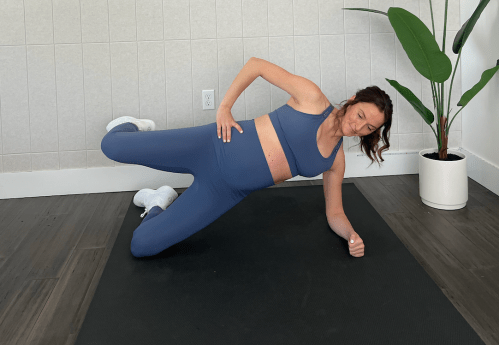
- 1.Lie on your left side.
- 2.Prop yourself up on your left forearm with your elbow in line with your shoulder.
- 3.Bend your knees and keep them stacked on top of each other.
- 4.Inhale and relax.
- 5.On the exhale, engage your core and lift your hips up into a plank, raising your top knee.
- 6.Squeeze your glute. Hold for one count and slowly lower down to starting position.
- 7.Complete 12 to 15 reps on each side.
5. Bear hold
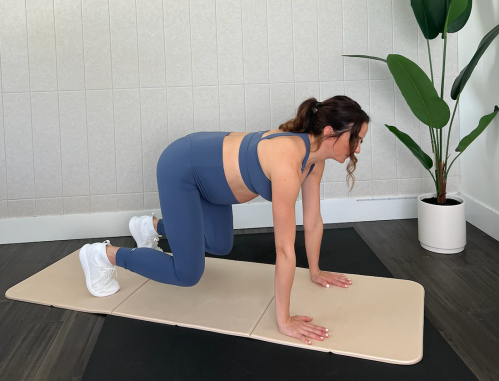
- 1.Start in a tabletop position on your hands and knees. Your hands should be directly in line with your shoulders and your knees should be directly in line with your hips.
- 2.Inhale, then exhale and engage your core as you press your palms down and lift your knees off the mat.
- 3.Hover your knees below your hips for 3 to 5 seconds, then slowly lower back down.
- 4.Complete 10 to 12 reps.
Tip: Focus on keeping the hips level the entire time by placing a block on your hips (or simply imagine one there).
6. Offset march
“This is another anti-tilt exercise that focuses on balance and stability,” Perry says.
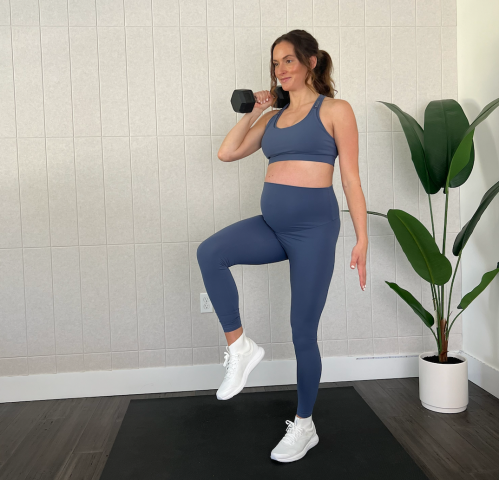
- 1.Stand tall with your feet hip-width apart, arms by your sides. Hold a dumbbell in your right hand (palm facing in toward your body).
- 2.Lift the dumbbell up so that the head of the dumbbell rests on your right shoulder, palm facing in.
- 3.Engage your core and shift your weight to your left leg.
- 4.Raise your right knee as if you were marching.
- 5.Slowly lower your right leg and repeat on the other side.
- 6.Complete 12 to 15 reps on each side.
Core exercises to avoid during pregnancy
1. Standard crunch
While they may be a traditional ab workout, crunches are an exercise to avoid when you’re expecting.
“Moves like crunches put pressure on the linea alba, the connective tissue that holds your abs together,” Perry says. “This area is already under stress from supporting a baby and extra stress can increase the chance of tearing the tissue and developing diastasis recti.”
2. Plank
As your pregnancy progresses, you’ll also want to phase out planks, which can put too much pressure on your core.
“If you have been incorporating planks and bodyweight exercises into your programs since before pregnancy, you should stop planking once you get to 22 to 25 weeks of pregnancy,” Kaiser says.
3. Bicycle crunch
“Avoid any quick twisting movements in your torso and extended exercises lying on your back, like bicycles and leg switches,” Kaiser says.
Twisting your torso can crowd the baby’s space, per UNC Health. And spending too much time on your back (including when you sleep) when you’re over 20 weeks pregnant can constrict blood flow to you and the baby, according to the Cleveland Clinic.
Sign Up for Our Daily Newsletter
Get all the latest in wellness, trends, food, fitness, beauty, and more delivered right to your inbox.
Got it, you've been added to our email list.










